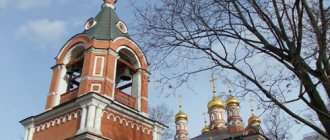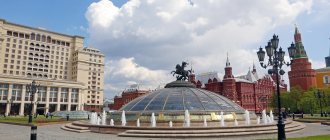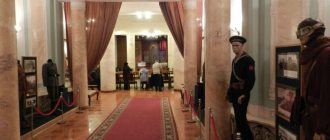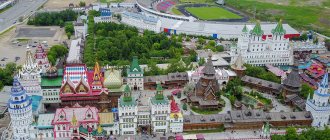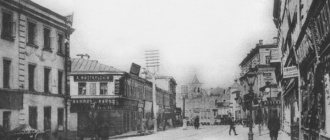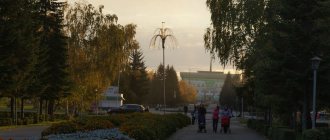Moscow Izmailovo is well known to all Muscovites. There is the largest forest park in Europe, the Izmailovsky Forest Park, where everyone can find something to do to their liking. The history of this place goes back to ancient times, the first mention of the village dates back to 1389. The history here is preserved in names, in monuments, in nature itself. Anyone who comes to this area will be struck by the colorful ensemble of the Izmailovo Kremlin. But lovers of antiquity frown with disgust when looking at him. This is a remake from 2002, and its caramel-gingerbread beauty has nothing to do with the true history of these places.
Estate of Tsar Alexei Mikhailovich
Izmailovo was the favorite country estate of Tsar Alexei Mikhailovich. He was actively engaged in farming and developing this village. The Tsar ordered the Serebryanka River flowing there to be blocked with dams. It overflowed, forming several ponds. The royal estate ended up on an island. These oldest ponds in Moscow were created in 1667. Along the banks of the ponds on Alexei Mikhailovich’s farm grew melons, watermelons, dates, and grapes that were exotic for those places. That is why the Serebryano-Vinogradnye ponds were named after the name of the river. Not far from the ponds there was a royal menagerie, where animals for the royal hunt were kept, including strange leopards, leopards, tigers, and lions.
Farming in Izmailovo was carried out on a grand scale. They were engaged in agriculture and crafts there. Alexey Mikhailovich personally delved into all the economic details and monitored the construction.
LiveInternetLiveInternet
The Church of the Intercession of the Virgin Mary was built for the royal estate of Izmailovo under Tsars Alexei Mikhailovich and Fyodor Alekseevich.
Consecrated in 1679 by Patriarch Joachim in the presence of Tsar Feodor. The three-nave monumental structure made of brick with individual white stone details is crowned with five chapters, the diameter of the central chapter is 8.5 m. The outside of the temple is decorated with outstanding multi-colored tiles (master Stepan Polubes, the “peacock eye” pattern, as well as various floral patterns). The inside of the temple has four pillars; the original interior has been lost (see below). The dome of the temple, colored tiled decorations are visible. After 1812 (when the temple was badly damaged by the invasion of the French, who burned bonfires in it), an almshouse for disabled people of the Patriotic War (later also of other wars of the 19th century; now the Bauman Town, architect Konstantin Ton) grew up around the temple. . When the almshouse was added to the walls of the cathedral, the porches adjacent to the church on the north and south sides were dismantled. In the 1840s, the iconostasis was restored. In 1854-1922, the Izmailovo list of the Jerusalem icon was kept in the Church of the Intercession (now in the Izmailovo Church of the Nativity, and in the Church of the Intercession there is a list). During Soviet times, the church was closed along with the almshouse (since 1918); in 1928, the NKVD archive, the most valuable icons preserved from the 17th century, were housed in it. The five-tiered iconostasis disappeared. Then a fruit warehouse was placed in the temple, the iconostasis structures were destroyed, and large icons went to fruit shelves (in the 1960s, the icons that served as shelves were given to the Andrei Rublev Museum of Ancient Russian Art). In 1970-1980, the cathedral was a warehouse for the Informelektro Research Institute, then the interiors began to be reconstructed into a concert hall. The temple has been operating again since the 1990s, and the few surviving icons have been returned to it. In 2001-2002 a new iconostasis was created. The rector is Archpriest Vladimir Bushuev. The source of
Serebryano-Vinogradny Pond is located in the east of Moscow, in the floodplain of the Serebryanka River (in the area of Pervomaiskaya Street), near the Partizanskaya metro station (Izmailovsky Park). One of the oldest city ponds, built in the 17th century. on the territory of the country estate of Tsar Alexei Mikhailovich, which is located on the island. Peter I made his first boat voyage here. Before the revolution, there was an Izmailovo almshouse for veterans of all wars. Serebryano-Vinogradny Pond is located in the floodplain of the Serebryanka River (therefore, in the 17th century it was called Serebryany or Serebryansky). The part of the pond known as the Grape Pond got its name due to the fact that various southern fruits and vegetables, including grapes, were grown in the orchards of Izmailovo - the estate of Tsar Alexei Mikhailovich. In the mid-60s of the 20th century, Serebryano-Vinogradny Pond was remembered. The remaining buildings on the island were restored and a stadium and sports grounds were built. The bottom of the pond was cleaned, the banks were strengthened, two boat stations were built, recreation areas and a city beach were equipped. Currently, the estate is a monument to landscape gardening art. The pond area is 17.5 hectares. The average depth is 2.5 m, the bottom is sandy and flat. Powered by ground and surface water, as well as from the water supply. The banks are reinforced with reinforced concrete slabs. The 1st Baumansky Bridge was built. The recreation area has a sandy beach, a children's playground with small architectural forms, 2 football fields, volleyball and basketball courts. There is a rental of sports equipment (roller skates). There are benches for relaxation under centuries-old oak and linden trees along the banks of the pond, and there is also a summer cafe. There is a boat station on the reservoir: boats and catamarans are rented. The recreation area is fenced with a decorative fence, there are 2 parking lots. Near the pond there is an exhibition and sale of arts and crafts products - “Vernissage in Izmailovo”. Work is underway to improve the recreation area and preserve the landscape and compositional connections with the architectural complex of the Izmailovo estate. Around the pond is the largest urban forest park (area - 1180 hectares). The territory of the former royal estate associated with the name of Peter I. Attractions. In summer: football, volleyball, tennis courts (clay), boat station (catamarans). Chess and checkers club. In winter: ski lodge, ice skating rink. Sports equipment rental.
Izmailovsky Island
A royal residence with numerous outbuildings was built on an artificial island in 1670-1680. The decoration of the royal chambers was more modest than in other palaces. Doors covered with red cloth with tinned hinges, small windows with mica, oak brick floors. The only furniture was tables and benches. But the economic services and workshops were in perfect order.
To enter the island through Serebryano-Vinogradnye ponds, a stone bridge was built, 106 m long and about 10 m wide. The bridge rested on 14 arches and ended with a three-tiered bridge tower. The tower was built in 1674 and has survived to this day. Regular gardens were laid out on Izmailovsky Island for the first time in Russia.
In the 1670s, the Izmailovo estate had one of the first home theaters in Russia. The name of only one of its actors has been preserved - the singer Vasily Repsky.
Peter I sailed on the waters of the Silver-Grape Ponds in a boat ordered from England.
Story
The history of the pond dates back to the early 1660s. Then the Izmailovo estate of Tsar Alexei Mikhailovich began to be transformed into an advanced economy for those times: to create gardens and greenhouses, develop hunting grounds and sow fields. In the bed of the Serebryanka River flowing there, several dams were built and numerous ponds were created: Lebedyansky, Prosyansky, Izmailovsky, Serebryany (Ilovaisky), Vinogradny, water mills were installed on them and water pipelines were laid from them[4][5].
A few years later, the bed of the Serebryanka River was deepened and a Grape Pond was created - so named because various southern fruits and vegetables, including grapes, were grown in Izmailov’s orchards[6]. At the point where the Steklyanka (or Khokhlovka) river flows into this pond, a second dam was built. The third dam, called Vistula, was built at the western edge of the Serebryany Pond, thus connecting it with Vinogradny and closing the water ring around the landmass - Izmailovsky Island[2]. Tsar Alexei Mikhailovich ordered to build his new residence on it and connect it with the rest of the land with a large white stone bridge[7][8].
Young Peter the Great made his first voyage on the Serebryano-Vinogradny Pond in a boat. For this purpose, another dam was built on Serebryanka - Prosyanskaya[9].
XX century
After the 1917 revolution, the dams were removed and bridges were built in their place[2][10].
In the mid-1960s, the remaining buildings on the island were restored and a stadium and sports grounds were built. The bottom of the pond was cleaned, the banks were strengthened, two boat stations were built, recreation areas and a city beach were equipped. Around the pond is the largest Moscow urban forest park with an area of 1180 hectares, the territory of the former royal estate[11][12].
In 1964, on the site of the old wooden bridge, the 1st Baumansky Bridge was built, which connects the town named after. Bauman with Izmailovskoe highway[6]. Another of the bridges connecting the island with the shore is curved in the shape of an arch. Because of the unique shape of this bridge, an urban legend arose: if a couple in love swims under the bridge and shouts out their names, then, having heard the clear echo, they will live in love and harmony[13].
In 1987, the Serebryanka River valley was declared a natural monument[14].
Intercession Cathedral
In 1671, boyar Artamon Matveev entered into an agreement to build a large stone temple on the island with artels of Murom and Yaroslavl architects. The Intercession Cathedral in the royal residence in Alexandrovskaya Sloboda was taken as a model for construction. The architect of the cathedral was Ivan Kuznechik; the zakomars decorated the “peacock’s eye” tiles. They were made by the famous master Stepan Polubes. The cathedral had wall paintings and a magnificent five-tiered iconostasis, which has not survived. It was painted by the famous icon painters of that time Karp Zolotarev, Fyodor Zubov, Vasily Poznansky. Masters from Yaroslavl and the Trinity-Sergius Lavra were also invited. In total, more than 40 masters worked on the paintings of the cathedral. A patriarchal place was made in the center of the cathedral, and choirs were built for the royal family near the western wall. The cathedral did not have a bell tower. The bells were located on the upper tier of the Bridge Tower.
Alexey Mikhailovich did not live to see the construction of the cathedral completed. He died in 1676, and his son Fyodor Alekseevich completed the construction. The five chapters of this cathedral are considered the largest in Moscow.
Shrine of the Intercession Cathedral
For the Izmailovo Intercession Cathedral, a copy was made of the original Jerusalem icon of the Mother of God. After the plague epidemic in 1771, the Orthodox began to especially venerate this icon. And in 1826, according to existing legend, it was she who stopped the cholera epidemic.
Tsar Fyodor Alekseevich loved to spend the summer on Izmailovsky Island, and after his death in 1682, Princess Sophia spent a lot of time there, who was very fond of gardens. Her brother Tsar Ivan lived with her, who sat on the throne with Peter I. Peter I himself did not live in Izmailovo, but often visited, staged funny fights, sailed along the Serebryano-Vinogradnye ponds on his father’s old boat. The leader of the Streltsy revolt, Fyodor Shaklovity, was caught on the island in 1689. After Sophia’s disgrace, Peter gave Izmailovo to his brother Ivan, and after Ivan’s death his widow Praskovya Fedorovna settled there with her daughters Ekaterina, Praskovya and Anna, who later became Empress Anna Ioannovna.
Mosvodostok divers cleared the Serebryano-Vinogradny pond in Izmailovo from dangerous debris
Serebryano-Vinogradny Pond in the capital's Izmailovo district is quite large (17.5 hectares) and one of the oldest man-made ponds in Moscow, located in the floodplain of the Serebryanka River, formed due to several large dams built here.
As you know, in the middle of the 17th century, Tsar Alexei Mikhailovich the Quiet (father of Peter I) did not particularly bother himself with foreign policy problems and intrigues, but was an unrivaled innovator in agriculture.
At the beginning of the 1660s, his Izmailovo estate turned into an advanced peasant farm, which at that time used the most advanced technologies. By the way, the Silver-Grape Pond received its name due to the fact that grapes and other southern fruit crops were grown on its banks. It was on it that the young Tsar Peter made his first voyage on his boat. And it was here that the idea of building his own fleet and making the country a great maritime power arose in the head of the young king.
Serebryano-Vinogradny pond in the area of Izmailovsky proezd, house No. 1. box 1.
Therefore, Serebryano-Vinogradny Pond can rightfully be considered one of the pearls in the crown of not only Moscow, but all of Russia. And pearls, as we know, should sparkle and shine, delighting the eyes of the current generations of Moscow and guests of the capital.
Bah, all the faces are familiar!
Diver of the 5th category of the State Unitary Enterprise "Mosvodostok" Mikhail Grekulov
The main tasks of the State Unitary Enterprise "Mosvodostok" are not only the maintenance of the city's drainage system, but also the maintenance of city reservoirs. The company services more than 250 water bodies.
Maintaining and maintaining the cleanliness of the bottom of Moscow’s water bodies: rivers, lakes, ponds, as well as hydraulic structures is the responsibility of the Department of Diving Works of the State Unitary Enterprise “Mosvodostok”. Mosvodostok divers are responsible for a comprehensive inspection of recreational areas with swimming, cleaning water bodies from household waste accumulated at the bottom, removing large-sized and foreign objects from the bottom of reservoirs and other work.
Today, the cleaning of the water area of the above-mentioned pond in the area of Izmailovsky Proezd, building No. 1, building 1, is led by Maxim Drobyshevsky.
The My Home Moscow correspondent has known him and his team for a long time. I observed their work on cleaning other reservoirs in various areas of Moscow.
True, today there was an opportunity to get acquainted with almost the entire technological process for removing particularly large and complex metal structures from the bottom of a reservoir.
But first things first.
The task of the diving team is to lift from the bottom a large metal pipe, which lies on the bottom, judging by the first examination, for a very long time and thoroughly grown into the silt, or, in the language of specialists: into the bottom sediments. Pulling out this “piece of hardware” will not be so easy.
Diver of the 5th category of the State Unitary Enterprise "Mosvodostok" Mikhail Grekulov is preparing for a dive
The diver will have to search for a submerged object in “zero” visibility
Fifth-class diver Mikhail Grekulov puts on work equipment: a neoprene wetsuit 7 mm thick, with a special protective “hoodie” on top, which protects the main wetsuit from mechanical damage (after all, the diver will have to move all kinds of pieces of iron underwater, possibly with sharp edges), gloves , twenty kilograms of lead weights, on a special cargo “bridle”, which are evenly distributed on the body, a cylinder into which is pumped under a pressure of 120 atmospheres of compressed air, a pressure helmet, a breathing mask with an underwater radio transmitter. The diving “equipment” is completed by boots with lead soles.
I describe Mikhail’s equipment in such detail so that our perhaps inexperienced reader can understand how difficult it is for divers to work in such equipment at depth with complete “zero” visibility, literally by touch.
– How long is “transparency” (visibility under water) now? - I ask Maxim Drobyshevsky, who, after Mikhail’s dive, conducted a radio exchange with him, giving him commands: “Take a sharp right. Good. Directly".
– Yesterday there was about a meter of visibility. Today it’s almost “zero”, due to the heavy rains that happened the day before, was the answer.
The head of the diving service of the State Unitary Enterprise "Mosvodostok" Maxim Drobyshevsky corrects the diver's movements towards the intended underwater object with which the team of divers will have to work today.
Don't wash it, just cut it
Soon Mikhail, as they say, by touch stumbled upon the desired object. The second diver of the 6th category of the State Unitary Enterprise "Mosvodostok" Oleg Marinets gives Mikhail a metal cable with which he must hook the found pipe.
Hooked. The cable became taut. But it was not there. The “piece of iron” sits directly in the ground. Apparently, this “pipe” used to be one of the metal supports of the old boat pier, and no one knows how deep it was driven at the time.
A decision is made to erode the bottom soil underneath with a special hydrant that will supply water under pressure. This is something like an “underwater shovel” for a diver. Divers call this unit a “pipka”.
“It washed away about a meter of soil,” Mikhail Grekulov reports via radio to the top.
Diving specialist Sergei Cherenovich delivers a stream of water from a hydrant under a pressure of 1.5 atmospheres, which erodes the soil at the bottom
- Step aside. Let’s try to pull the winch,” the head of diving operations, Maxim Drobyshevsky, instructs the diver.
- Left?
- Yes. Pull!
The winch hummed loudly. The cable stretched like a string. To no avail.
- Misha come out. We'll cut.
Now it’s Oleg Marinets’ turn to go underwater. The fact is that according to the rules of all diving work, there is a strict distribution of job responsibilities depending on the qualifications of the diver.
Oleg Marinets has the 6th category. He is qualified for work such as underwater cutting of metal structures and welding. It was decided to cut the pipe and lift it to the surface in parts.
Diver 6th category of the State Unitary Enterprise "Mosvodostok" Oleg Marinets returns the hydrant hose after erosion of the soil under a flooded object to the shore
Diver puts on underwater equipment
Divers cut all kinds of iron underwater with approximately the same devices as on the surface, only underwater electrodes differ sharply from land ones, and they cut iron by touch with “zero” visibility and in an environment that is 800 times denser than air. As they say, feel the difference.
Our diving team needed about a dozen underwater electrodes to cut the pipe underwater at a depth of just over two meters.
Oleg cut, Mikhail gave him electrodes.
Diver Mikhail Grekulov hands electrodes to his colleague from the surface. Notice how the water boils and “smoke” rises to the surface from the bottom
Finally all the preparatory work is completed. Divers hook pieces of the “hated” pipe onto the cable and the winch easily pulls it ashore.
To pull out several pieces of just one pipe, sawn into pieces, with a diameter of 200 mm, it took a team of divers from the State Unitary Enterprise "Mosvodostok" 2.5 hours
This is such a difficult job for them.
Andrey FEDOROV.
Photos and videos by the author.
Izmailovo in the 18th-19th centuries
After the capital was moved to St. Petersburg, Izmailov’s importance tripled. But both Anna Ioannovna and Elizaveta Petrovna spent time here.
During the Patriotic War of 1812 the French were here. Trying to keep warm in the frosty winter, they burned bonfires in the Intercession Cathedral, which caused the iconostasis to crack and one dome to tilt.
In 1837, Emperor Nicholas I gave his possessions as an almshouse for the lower ranks who suffered in the Patriotic War of 1812. The almshouse was attached to the Intercession Cathedral from an architectural point of view, not very successfully. So the cathedral became the house church of the St. Nicholas almshouse. It existed on the island until 1917.
Izmailovo was visited by many famous people, including A. Dumas, who was interested in the history of Peter I.
Nowadays
In Soviet times, the island was called the town of Bauman, and ordinary people lived in the former rooms of the almshouse and there were premises of various research institutes. The Serebryano-Vinogradny pond in Izmailovo was abandoned and became shallow. In the 80s, it was planned to convert the cathedral into a concert hall. But the project was never implemented. In the early 80s, artists exhibited their works on the island and this became the beginning of the current Vernissage, which is located near the new Izmailovo Kremlin.
Now this beautiful place still attracts Muscovites. And many people ask about how to get to Serebryano-Vinogradny Pond. If you use public transport, you need to get to the Partizanskaya metro station (formerly Izmailovsky Park) or to the Izmailovo station of the MCC.
Town named after Bauman
Serebryano-Vinogradny Pond is also famous for the fact that there was once a workers’ town on the island.
Back in the 1920s, during the Soviet era, good living conditions were created for the working class of the largest industrial enterprises. They moved from poor barracks and dugouts to new quarters specially built for them near their place of work.
A town for workers was also organized on the island of the pond in 1924. 3,000 people lived in it - these were workers of the Moscow electric lamp plant with their families. They lived precisely in these royal chambers, in this 17th-century estate.
Of course, after the war in 1945, new houses were built in Izmailovo for MELZ employees, but these communal apartments in the town named after. Bauman (Russian revolutionary) were completely resettled only in the 1970s.
Today on the island there is the Izmailovo estate, the Academy of Restoration, a branch of the State Historical Museum. Unfortunately, the wooden buildings and the royal palace of those times have not survived.
The site on the shore of Serebryano-Vinogradny Pond and all the adjacent natural areas are a wonderful place of recreation and entertainment for lovers of both passive and active recreation. A pleasant pastime here can be combined with cultural education by visiting the Historical Museum and the territory of ancient buildings.

